Serviços Personalizados
Journal
Artigo
Indicadores
-
 Citado por SciELO
Citado por SciELO -
 Acessos
Acessos
Links relacionados
-
 Similares em
SciELO
Similares em
SciELO
Compartilhar
e-Journal of Portuguese History
versão On-line ISSN 1645-6432
e-JPH v.6 n.2 Porto 2008
Army size, military recruitment and financing in Portugal during the period of the Peninsula War – 1808–1811
Fernando Dores Costa
Department of History ISCTE [Lisbon]
E-mail: fdcta@iscte.pt
“Everyone wishes for the defense of the Realm, but few remember this duty when it affects people with whom they have relations: in this manner, the Army would never be recruited.”1
Abstract
This article is intended to offer a preliminary approach to some questions that were of central importance in the period of the so-called Napoleonic invasions in Portugal: the size of the army that was effectively raised, the difficulties that were encountered in recruiting men to serve in the ranks of this army, and finally the shortage of funds to finance the efforts to sustain this force. This is not an account of the Peninsular War on Portuguese territory, but makes some contributions to the renewal of the study of this period, namely through the use of quantitative sources.2
Keywords
Peninsular War, military recruitment, war financing, British subsidy, financial reform
Resumo
Este artigo pretende ser uma abordagem preliminar de algumas questões de importância central na época das chamadas “invasões napoleónicas” em Portugal: a dimensão do exército efectivamente levantado, as dificuldades que foram encontradas no recrutamento para as fileiras desse exército e, por fim, a escassez do financiamento para o esforço de sustentação dessa força. Não se trata de um relato da Guerra Peninsular em território português, mas de alguns contributos para a renovação do estudo deste período, nomeadamente através da utilização de fontes quantitativas.
Palavras-chave
Guerra Peninsular, recrutamento militar, financiamento da guerra, subsídios Britânicos, reforma financeira.
I A demilitarized realm
In the first letter sent to the government of Rio de Janeiro, dated October 18, 1808, the “restored” governors painted a picture of complete demilitarization. The whole realm had been disarmed, they claimed. The arsenals of the army and the navy had been emptied and the army entirely annihilated; under the command of the Marquis of Alorna, the cavalry, infantry and artillery force that had been chosen by him had been taken to France. Despite the fact that the Junta do Porto had not only ordered the thirteen regiments of the northern provinces to be organized with those soldiers who had been discharged at different times since 1801, together with their former officers, but had also created four battalions of caçadores (“chasseurs” or light infantrymen) and trained the militias of the aforesaid provinces, many of these forces were useless because of their lack of weaponry. What was more, the Algerians were infesting the seas and had already captured some boats along the coast.3
This state of affairs—in a realm where there was no military tradition4—was the expected result of the Napoleonic government’s program for domination, which logically involved the elimination of all fighting capacity. In view of the traditional aversion to military service, the demobilization of a part of the military force may even have been welcomed with some pleasure.5 The disarmament of the population meant that all individuals who were found with a weapon could be treated as irregular combatants, not covered by the (supposed) laws of war, and summarily executed. Later, this concern with the use of weapons also extended to the pikes outside drinking houses.6 The means that should be used in conquered countries were made perfectly clear by Napoleon to his brother Joseph, then king of Naples, criticizing his conciliatory measures. There should be no mistake: all conquered nations should present themselves by “déguisant leur sentiments et leurs moeurs, et se prosternant avec respect devant qui a leurs biens et leur vies dans les mains.”7 On the other hand, in the context of Napoleon’s plans for the countries now included within his sphere of influence, the creation of the “Portuguese legion” brought two advantages: the destitution of the best officers and best troops of the realm and the acquisition of operational forces for the execution of his own objectives.8
The defeat of Junot’s forces was achieved with the help of the British expeditionary forces, the governors of the realm were reinstated by General Dalrymple and Lisbon remained under the supervision and vigilance of the British troops. Napoleon’s troops were forced to leave the Lisbon region through an agreement for the transfer of powers drawn up between officers from the French and British armies, without any influence being exerted by the scanty Portuguese troops or their leaders. In the second letter sent to Rio, dated November 16, 1808, the governors reported that a part of the English army that now found itself in Lisbon had left for Castile. Two regiments had marched to the city of Porto, at the request of the governors, “with the aim of bringing peace and tranquility to the people.” The rest, roughly nine or ten thousand men, were retained in Lisbon under strict discipline and with all the expenses of their pay and maintenance being borne by Great Britain.
In the letter of December 24, 1808, it was claimed that efforts continued to be made to complete the organization of the army, which was said to be so necessary. A report was made of the measures taken and a chart drawn up showing the state of the army. Plans were also made at that time for a force to march to the aid of the Spanish neighbors, consisting of eight infantry battalions, eight cavalry squadrons and two hundred artillerymen with eight cannons, with António José de Miranda Henriques as commander-in-chief. All of this was to take place despite the “great sensation” that the French attack on Madrid had caused throughout the realm.
The panorama was to change completely a month later. The governors reported that General Cradock had embarked in Lisbon with two of his regiments and had ordered the withdrawal of the troops that were in Almeida and Castelo Branco, creating great alarm amongst the inhabitants of that region. The minister Villiers, the British diplomatic representative, had asked for orders, similar to those that had been granted in 1807, to allow all the English to remove their possessions and effects, without the payment of any duties, guarantees or any other encumbrances, and had warned the governors of the need to prepare all of the Crown’s boats to be saved with all their naval munitions. There was, in this letter, a clear expression of discontentment in relation to the British: all “these arrangements show that the English only care about saving all that belongs to them, and to the Navy, without them being concerned with the defense of the realm, for they have given no money, or arms, and only some pikes, and 2400 rifles, failing to provide for extraordinary and indispensable expenses, not only for the Militias and Ordenanças (territorial non-professional troops), but also for part of the Front Line Troops.”
In the absence of any outside help, the picture that was painted was an extremely weak one. Discouraged, without either money or arms, finding the realm now deprived of the help and energy of the Spanish and the English, on whom they had depended so greatly, lacking experienced generals and the confidence of the nation and with a large number of “Jacobins and Freemasons,” the governors explained that they were taking such measures as were possible, including providing Lisbon with some defense.9
The march of the force assigned to help the Spanish had been suspended and then, after its reinforcement, it was stationed between the Tagus and Mondego rivers, defending the crossing of the River Zêzere, and close enough to help defend the bridge at Ponte de Murcela. In the event of a withdrawal, this same force would gather together with forces covering Beira Baixa and others that were stationed in the neighborhood of Guarda to help in the defense of Beira Alta, retreating as far as Lisbon if this were to prove necessary. It was expected that such a withdrawal would be made more difficult by the absence of other forces that could provide support, and orders had therefore been given to fortify the most important places in Estremadura along the two roads from Leiria and “Borda d’agoa” (along the shore). The “people” from their surrounding areas were also told to gather together and store there all the provisions and supplies that they could muster.10 We may consider this to be a first simplified plan for the defensive system of the future Lines of Torres Vedras.11
This was therefore the beginning of a period when military mobilization was to take place on an unprecedented scale.
II The size of the armed forces
The force established in the Decree of October 14, 1808, was as follows:12

But this was a force that was only created on paper.13 Obviously, if it had been an effective force, the whole military history that took place on Portuguese territory during this period would have been quite different.
Shortly afterwards, this was to be confirmed by the direction taken when Napoleon’s victories in Spain unexpectedly changed the state of mind and the military situation in the Iberian Peninsula, a “militia-based” orientation expressed in the decrees of December 11, 1808, “calling the nation to arms” (this, significantly, was the title given to it by Chaby), and of December 23 and 28, creating the 16 legions of Lisbon and the forces of commerce.14
A first and more detailed report of the size of the military force refers to the situation in February, 1809.15 Two armies could be distinguished within it.
A – The Army stationed between the Mondego and Tagus rivers intended to protect the capital. Its commander-in-chief was Lieutenant-General António José de Miranda Henriques, and its headquarters were in Tomar, defending the line of the Zêzere and Alva rivers. This army had two advanced companies, both dependent on the force led by General Miranda.
B – One in Beira Baixa, led by Colonel Carlos Frederico Lecor, with its headquarters in Castelo Branco.
C – Another in Beira Alta, led by Field-Marshal Manuel Pinto Bacelar, with its headquarters in Guarda.
Another army was the Army of Entre Douro e Minho, whose mission was to defend the northern provinces and protect the city of Porto.
D – This army had a main force, led by Lieutenant-General Bernardim Freire de Andrade. The second-in-command was Field-Marshal José António Botelho.
E – and another force in Trás-os-Montes, led by Brigadier Francisco da Silveira Pinto da Fonseca, with its headquarters in Chaves.
Other forces were identified, protecting garrisons and ports:
F – To protect the fortress of Almeida, governed by Brigadier Matias José Dias Azedo.
G – To secure the left wing of the position of Alva and the city of Coimbra, commanded by Field-Marshal Nuno Freire de Andrade.
H – To reinforce Porto, help in the defense of the banks of the River Douro or the defense of the Serra do Buçaco, linking with the left wing of General Miranda.
I – Porto, the interim governor being Brigadier Caetano José Vaz Parreiras.
J – Lisbon, the governor being Lieutenant-General Dom António Soares de Noronha.
K – Alentejo, the governor and commander being Lieutenant-General Francisco de Paula Leite, with its headquarters at Elvas.
L – Beja.
M – Algarve.
N – Setúbal, led by Lieutenant-General Manuel de Almeida e Vasconcelos.
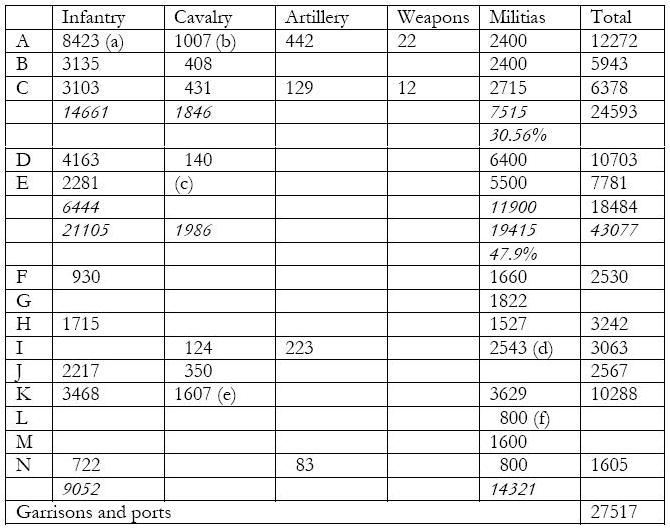
(a) Four brigades with 5, 4, 4 and 5 battalions respectively, comprising 2300, 1329, 2457 and 2331 men.
(b) Note: “almost all unarmed.”
(c) “Remains of the Regiments of this Province, poorly armed and with little strength.”
(d) Also including 173 men as “irregular troops.”
(e) Sum of 818 from the “remains of the regiments of the provinces” and 789 from “17 companies of mares.”
(f) Identified as the “Regiment of the militias of the Algarve.”
In this chart was presented a force totaling 70594 men, which included the soldiers from the armies of Beira (24593) and the North (18484), as well as the garrisons and ports (27517). This number would be highly significant if it were real. Yet it is sufficient for us to consider the declared total of the supposedly “professional” (non-militia) infantry, 21105 men in the two armies and 9052 at the garrisons, or, in other words, 30157 infantrymen, in order to immediately have another perspective. Even this number is not believable, in light of the events and the numbers found in 1810 and 1811.
But the governors themselves were to recognize the lack of quality displayed by these forces. In reply to what the Count of Linhares had written about the organization of the army, they guaranteed that, immediately after the reinstatement of the government, they had considered the importance of help being sent to Spain. But the armies that had been formed in the different provinces of the realm were a “monstrous hotchpotch”—this was the eloquent expression that they used—which served as proof of the extraordinary efforts that these provinces had made, but which could not in any way be considered as amounting to regular armies. According to the description that was made of them, these were forces composed of detachments from different regiments and most of them consisted of recruits who had served two weeks or a month, and which were increasing in number, but not in strength. Many of these forces were unarmed and most of the armed ones had very poor and unevenly distributed weaponry.16
In the report of August 14, 1809, returning to the theme of the criticisms that were being received from Rio de Janeiro, it was claimed that it would undoubtedly have been desirable if, immediately after the “restoration of the kingdom,” a numerous and highly disciplined army could have been sent to Spain, but, in view of the state of Portugal, its army, its stores, treasury and resources, nobody could feel “flattered” that all this appeared to have been achieved in the short space of two months, the time between the end of September, when this government had taken office, and the beginning of December, when Bonaparte had taken Madrid and invaded Spain with such an extraordinary force as the one that he had used that winter in the Iberian Peninsula. They also argued that the unfavorable outcome of the conflicts in Spain had not been the result of a shortage of men. It was not armed men that Spain needed, wrote the governors, nor could these disasters be attributed to a lack of numbers. What had been missing was discipline and order, the experience of their general officers and, above all, a single leadership that could ensure the better employment of these forces and their movements. In conclusion, they did not suppose that the increase of twenty or twenty-five thousand organized and disciplined armed men (even if it were practicable to send them immediately to Spain, just as they had made clear) could have avoided the disasters that were experienced or that this would have made them capable of halting the relentless progress of the French invasion.17
A chart showing the situation and strength of the different forces of the army in October 1809, dated as being issued by the Palace of the Government on October 24, 1809, referring to the troops by their location, counted 46,971 men and 5,015 horses. Also itemized were 42 cannons and nine obuses and means of transport: 271 oxen, 565 draft horses, 629 horses for heavier loads, 119 for lighter loads. As well as 473 “moços” or young single men (but this information only related to some provinces).
Considering the numbers published for the years from 1809 to 1811, we can see that the total number of infantrymen raised seems to have been around 33 thousand men, and a little higher at the end of 1810 [see Appendix nr. 1].
As far as the cavalry is concerned, the number of cavalrymen seems to have been estimated at close on six thousand, although in reality it was lower than four thousand. One should note the surprising and continuing shortage of horses for the numbers of cavalrymen said to exist at each of the cavalry regiments. The number even fell between 1809 and 1811 [see Appendix nr. 2]. The breeding of horses and their acquisition for military purposes had represented traditional difficulties for the forces of previous centuries.18 An idea can be formed of the “requirements” of the formation of the cavalry in relation to the total number of horses existing in the realm from the figures published in the lists drawn up for recruitment purposes on October 11, 1808.
“Number of Horses existing in the different Districts of the Realm and the Neighborhoods of Lisbon in 1808”19
Trás-os-Montes 911
Minho 716
Beira 807
Algarve 453
Alentejo 1010
Estremadura 1944
Partido do Porto 675
Total 6516
Basically, it can be noted that the number of horses needed to form the expected cavalry force was roughly equivalent to the number of horses existing throughout the kingdom.
In summarized form, the overall strength of the army between 1809 and 1811 evolved as follows:

This simple comparison might suggest the existence of a certain stability in the composition of the army. We do, however, know that this was not the case. The units lost men constantly, either through desertion or through their becoming incapacitated, and efforts were made to restore numbers by recruiting new men, integrating volunteers and recapturing deserters who were on the run. We can therefore compare the number of recruits and deserters between January, 1810, and June, 1811:

The number of deserters recorded during this year and a half corresponded to 22% of the total number of soldiers recorded at the end of 1809 (20% of the total at the end of 1810) and 25.3% of the total number of infantrymen. During these eighteen months, the number of deserters was roughly two thirds of that of the recruits, or in other words only one in three of the newly incorporated men actually increased the strength of the army. In fact, the true picture was a little less unfavorable in view of the existence of 4132 volunteers and 2392 deserters who were recaptured.20 In this way, we can see that there continued to be a constant breaking up and renewal of the units.21
The first—and decisive—question is that of assessing these efforts at mobilization, comparing the size of the military force with that of the population as a whole. We know that this comparison is made more difficult by the shortage and poor quality of the information available about the population and its structure in terms of sex and age. We do, however, have a table showing the number of “moços” recorded in the year of 1808. This chart was the result of an initiative of the governors of the realm, dated October 11 of that year, which required the generals of the provinces to issue the commanders of the ordenanças with an order to state, by companies, the number of single men and caçadores by profession.22
General Chart of the young single men subject to recruitment in 180823
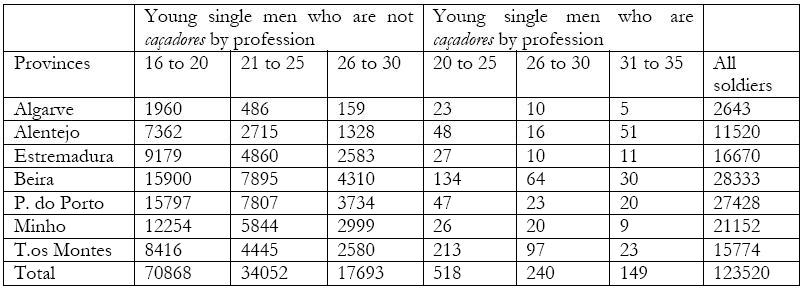
Let us accept these numbers of the population involved in military affairs. The ratio between the overall strength of the army and the above-mentioned population (using the highest number for this, the one dating from 1810) amounted to 43.3%, close to half of the bachelors aged between 16 and 30 years of age.24 We should also highlight the contrast between the extremely low number of “young single men” in the provinces in the south of the country (Algarve and Alentejo) and the high concentration of this category in the provinces of Beira, Partido do Porto and Minho (62.3% of the total). But the problems were far from being limited to the shortage of recruitable men.
III The difficulties of military recruitment
In the period from 1808 to 1810, the general superintendent of police was given various duties directly relating to the efforts of military organization. Two of these were crucial: military recruitment and the mobilization of means of transport. The superintendent was also given other tasks to perform, such as taking care of the accommodation of British officers or dealing with the issues raised by the imprisonment of men of French origin or those accused of being their supporters.25
Military recruitment was generally an occasion for making accusations about the “excesses” perpetrated by the authorities placed in charge of performing this task and for making use of the privileges that exempted those holding them from the performance of military service.26
The superintendent received notices from December 10 to 16, 1808, from the Office of the Secretary of State for War, which he then sent on to the ministers of the recruitment districts, ordering them to apply their instructions. But, on being told that the criminal judge of the district of Andaluz had committed excesses in the execution of these orders, he summoned him to his office and issued him an official warning. Meanwhile, a notice dated December 24 instructed him to censure all the ministers of the districts for the “excess” resulting from those who had been exempted in accordance with the decree of October 22, 1807, at the same time recommending to them that they should rapidly recruit all individuals who were not entitled to special privileges, of which there was a great abundance in the capital. But he seemed to want to shift these responsibilities by making the observation that he had been told that the disorder had, in part, been motivated by the officers of the ordenanças, who either with or without orders, had proceeded to implement this measure, practicing the abuses that, in similar cases, were quite common, going so far as to order the closure of shops.27
At the same time, there still continued the traditional conflict over the privileges of the militiamen, and, consequently, the confrontations between their officers and the ministers of justice. Such privileges were seen as essential in order to encourage these men to join the ranks of the militias, the supposed second line or reserve force of the war effort. For this reason, the denunciations that were made by a local magistrate of the abuses that militiamen had made of their status seem not to have merited the support of the Secretary of State for War.
The chief magistrate of Alenquer, Manuel José Soares de Lobão, wrote to the superintendent of police about the absurd “persuasions” that some militia officers imposed upon their soldiers. While the external defense of the state called for armed men, the internal peace required that there was respect and obedience for the civil authorities, he said. On the contrary, the officers convinced their soldiers to totally disobey the magistrates. They claimed that only through the immediate orders of their colonel could they be either summoned or arrested, and that, if they were to be summoned by the magistrates or should these wish to arrest them, then they would turn against the same officers of the law and arrest them at the orders of the colonel and take them immediately to Torres Vedras. They even added, “most audaciously,” that they would beat the ministers if they were to come and arrest them. These were dangerous claims made against “a rough People,” and they even convinced themselves by them that they were exempt from the defense tax or the payment of subsidies.
Curiously, the comment that was made in a note annexed to the document (which must have been made by the government secretary) contradicted the magistrate. It said that, in other times, complaints were made because a minister who deliberately disrespected the privileges of the militiamen was not punished, and, if any exemplary punishment were to be made now, there would never be any militiamen in Portugal. For this reason, it seemed that the minister should be reprimanded for exceeding his authority.28
Another form of behavior that gave rise to suspicion was the refusal by the leaders of the regiments to accept the recruits that were sent to them for reasons different from the ones that were actually invoked. These were referred to by the magistrate from the recruitment district of Alfama when he drew attention to the fact that nine recruits had been sent from the town of Setúbal, and that in the case of six of them, he was convinced, there was no justification for their having been rejected. Some had been refused because they were half an inch too short in height, and others had been rejected because they were not “well built,” when they displayed no sign of injury, illness or lameness, although they had been examined by a surgeon that he had for this purpose. The magistrate said that he had wanted to send them to prison so that he could then inform the superintendent of this fact, but the lack of any means of subsistence had prevented him from doing so. He was having great difficulty in finding men who contained as many perfections as were required by the commanders of the regiment, despite the continuous work that he had had to complete, even because of the privileges that appeared every day. He identified, in the case of his own district, the shelter that was provided by the Grilo Military Hospital, whose director even demanded that he be supplied with young single men for the performance of services for which any men would do, and where he was told many others were hidden. He therefore asked the superintendent to tell him what he should do if they were to send him other recruits that had been rejected.29
Military recruitment was confronted with deep-rooted social resistance, about which the superintendent found himself forced to reflect, in response to the representations that several capitães mores30 had been making to him about the obstacles that they encountered in seeking to fulfill the orders that were given to them to “make ready” the number of recruits necessary for the army. He expressed his formal opinion about such difficulties on June 15, 1810.
The obstacles that the capitães mores highlighted were:
1 – the emigration of a large number of moços, who were thus taken away from military service, moving to Lisbon and its surrounding area and to the province of Alentejo;
2 – the reception that they were given in homes of people, who in this way sought to save them from recruitment;
3 – the abuse that many parents engaged in, rescuing their children by concealing them in small villages and special hiding places.
The first of these inconveniences—said the superintendent—had been provided for in paragraphs 10 to 15 and 17 of the Charter of December 15, 1809. The first five paragraphs established the penalties that people would be subject to when leaving their land in order to avoid recruitment, while the last one established the proviso that magistrates would not grant a “passport to any person subject to recruitment by virtue of his age and state, unless they are shown certificates of exemption.” Nothing more remained to be done than to ensure due compliance with the aforesaid charter, because of its authority and the importance of its subject matter. As he said, the law was being applied. The capitães mores had sent him the reports of young men who had gone absent, which the superintendent then sent to the appropriate authorities (provedores)in the districts (comarcas), which in turn effected seizures, sales of goods and the transfer of the proceeds from this sale to the Military Treasury.
Note that in this way the punishment to which he referred reached the highest point of what the European tradition of monarchic legitimacy described as tyranny: the sequestration of the property of those who escaped the actions of military recruitment broke completely with the “constitutional” rule that dictated that the royal power could not be used to destroy the social statuses of individuals. Through their disobedience, the latter ceased to be property owners and were reduced to the lowest social condition. It was therefore considered that the situation of extreme necessity justified the destruction of the social status of those who escaped the mobilization orders. The state that applied this law had more powers than the kings of the Ancien Regime.
As far as the other measure was concerned, continued the superintendent, namely that of declaring exemptions from military service on passports, this had also been put in practice in the city of Lisbon and had also been observed in the case of some of those that had been issued in the provinces. But the difficulty consisted in obliging all those who had “stealthily” left their home regions to equip themselves with passports. First of all, because paragraph 3 of the Charter of August 13, 1760, exempted from this obligation to hold passports those who were moving from one region to another within the same districts (comarcas), so that, with there being no need to hold a passport when they did not leave their own districts, it was not possible to check the upholding of the provisions of this new Charter. Second, because those who were furtively sneaking away from their home regions did not protect themselves with a certificatory document, the need for which they managed to evade, insofar as a “country peasant” was not a man who aroused suspicion in his travels and also because in most of the regions the officers of the law were busy dealing with so many cases that they could not observe and control wayfarers and also because the work of building fortifications and transport routes, and also working on the land did not leave any extra people available to perform the necessary supervisory duties.
The only expedient that seemed to remain available was the measure of extending the penalties that had been established by the Charter of September 6, 1765, against those who gave shelter to deserters, against those who took in and hid people who were subject to recruitment, because although the oath to the flags made the obligation not to abandon them more sacred, as far as political duty was concerned, those who denied the defense of the realm were just as guilty as the deserter, for, in both cases, they were equally failing to fulfill one of the main duties of the social man, as was stated in paragraph 12 of the above-mentioned Charter of December 15. Without this support, the fugitives would find themselves obliged to voluntarily enlist or to return to their own homes.
In this way, what had been suggested about the tyrannical nature of the expropriation of fugitives was confirmed. The full scope of this transformation should be stressed: the compartmentalization disappeared between the “military society”—to which the men who took the oath remained linked, which legitimized the heavy punishment meted out to those who helped them—and “society” in general, and an equivalence was established, within the sphere of “political duty,” between those who deserted and those who denied the “defense of the realm”. This duty applied to all men and “society” became overall a “military society.”
The second obstacle that was highlighted by the capitães mores would also be avoided through the implementation of this measure, added the superintendent. The third obstacle was, however, more difficult to remedy, he stated. Helping a son who was hidden was “so to speak, a family affair.” Who would denounce this crime? Not the father who helped him, nor the brother or any relative, because such an act was odious to all, according to common opinion. The proof of this crime was, for the same reason, equally difficult to achieve; the embarrassment that this caused the capitães mores was a clear demonstration of this fact. And when one fought against popular prejudices and errors, it seemed that the Laws even lost their authority. A peasant considers the son who is obliged to take up arms to be a poor unfortunate: distinctions in service, privileges of exemption, acts of benevolence, etc. all of these caused a recruited soldier to be considered a downtrodden and downcast man; and it would be necessary to destroy all of these prejudices to make a peasant give up his son with pleasure for military service.
Perhaps this could be obtained indirectly, by honoring the condition of the soldier with signs that clearly demonstrated that the government appreciated and valued them, such as giving them the right to opt for a post in the ranks of the ordenanças when they obtained their discharges or when peace was made, or even when they were rendered incapable of continuing in military service. In the same way, suitability could be recognized for holding official positions in the municipalities, with preference being given to the fathers who had the highest number of sons who were soldiers. For the same reason, the unsuitability of others could be recognized for these same posts and positions whenever sons entered into flight or fathers acted in such a way as to favor this. In this way, all those who aspired to hold posts in the ranks of the ordenanças and official positions in the municipalities would be “inspectors of the Defense of the Realm”.31 Significantly, the only proposal that the superintendent had found (and which was far from being original) was manifestly a weak one: the number of places in question was very small and it would only be of interest to a few members of some social groups.
Yet, the behavior adopted by the superintendent himself towards particular cases illustrates how different forms of escaping recruitment persisted. For example, the exemption of fishermen and sailors from military service was recognized in a way that seemed to be far too easy. This was the case, for example, with José do Ó, born in Olhão, a fisherman who had been recruited and would have been considered amongst those exempted because they were employed in navigation and fishing, according to the aforementioned charter of December 15. The proof that was required made it possible to forge rather too easily the evidence that showed one belonged to exempt activities.32 In some cases, we are left with the feeling that the superintendent himself exercised a form of protection. João Nabor Bernardes, who had been arrested in order to serve as a recruit in Regiment nr. 22, requested his release, alleging that he had been formally excused from military service because of an illness that had rendered him incapacitated. The superintendent had ordered him to inform the magistrate from Rua Nova, who, referring to the declaration issued by the assistant surgeon that had examined him, had then stated that he was not currently known to suffer from any illness. However, he still continued to say that he considered to be of great importance the certificate issued by the five surgeons from the Brigade that the petitioner had enclosed with his request for exemption, as well as the consideration of the fact that a sufferer from rheumatism, “even if only at intervals,” was unfit for a service that exposed men to all the adversities of the weather and that this illness was more suited to patients in hospitals than defenders of the monarchy, so that he had instructed, through an order issued on June 26 that the petitioner should be released. But he had not been able to take advantage of this situation, as he had already marched as a recruit to Setúbal. For this reason, he was directing himself to “Your Royal Highness” to deign to release him.33 In another case, the protection came directly from the government secretary, against the opinion of the superintendent. The man in question had been enlisted as an individual without any occupation. Having been called for an examination of his fitness for service, he had shown an attestation in which he was described as being employed as a clerk at the hospital, this document having been issued in May and without any mention of the date on which he had been employed in this post. For this attestation to have any validity, it would be necessary for it to state that he had been employed prior to the publication of the charter of December 15, 1809, for the subsequent laws would not exempt men obliged to enter recruitment and considered fit for service such as he was, a single young man aged 20 and five feet three inches in height.
It was under such terms that he had been recruited and sent to the depot of Val de Pereiro, which he could leave whenever he wanted since, without waiting for the grace that he requested, he had obtained the favor of being allowed to walk around Lisbon. It was about this man that the description was written that I placed as an epigraph to this article: the fact that everyone wished for the defense of the realm, but few remembered this duty when it affected people with whom they had relations, and, in this manner, the army would never be recruited.34 The sphere of interests—that world which motivated men daily, centered around their subsistence, status and network of protection—not only did not allow for the establishment of the sphere of defense, it represented a constant and persistent obstacle against the authority that sustained and supported the organization of available forces that could be mobilized. And this happened because the exercise of this authority was seen as equally destructive (or, because of its proximity, perhaps even more annihilating) of the order of interests.
After 1811, although war operations had ceased to take place on Portuguese territory, the pressure of recruitment was maintained, not only because the conflict remained close at hand and undecided, but because Portuguese soldiers continued to belong to Wellington’s army until victory was achieved in 1814.35
The traditional difficulties in carrying out military recruitment persisted, and, in May 1811, William Beresford identified for himself the reasons that prevented the front line troops being completed. Desertion and disease were the main causes for the reduction in the size of this army. The effects of desertion came, he claimed, from the negligence of the magistrates and the capitães mores, who did not always fulfill their duties, since most of those abandoning the service returned to their homes, where they could easily be found. He therefore considered it necessary to adopt other means and proposed the imposition of a fine upon the whole of a district in which a deserter was found. The amount of this fine should be one hundred (or at least fifty) thousand réis. A third of this sum would be paid to the informant and the rest to the military treasury. The fine would be paid in equal parts by the magistrate and the district. Beresford once again confirmed the existence of a complicity of reluctance (or, at least, an inhibition) on the part of the magistrates, identified since the 17th century, in dedicating themselves to the repression of desertion, since this called for the oppression of the local communities who protected the men in flight. Furthermore, Beresford continued to denounce the social inequality to be found in recruitment, which was associated with the venality of the capitães mores and even of the colonels of militia forces. Members of the first class, or, in other words, the rich, never joined the army, since these knew how to gain exemption and it would not be particularly scandalous to state that it was known that everything could be obtained through money or intrigue. In obtaining places, Beresford continued, there was opposition, intrigue and payment to be made, and the militia commanders reimbursed themselves whenever they had a chance to do so. All complaints derived from this, not only about recruitment to the front line, but also about the colonels of militia forces or about the disorganization of the ordenanças.
Significantly, he confirmed the use of armed gangs in the previous campaign of 1810, but he presented these as a temporary recourse subordinate to the military command of the front line troops, pointing out that he had issued orders to the generals of the provinces to disband them and to send the people employed in these armed gangs guerrilhas instead to the second and third lines, militias and ordenanças, thus avoiding the damage that they caused.36
IV The inevitable financial crisis
Sustaining an army of the size described above was an almost impossible task for a weak administration finding itself in a particularly unfavorable economic situation.
An “official” approach to the question estimated annual costs by considering 80 thousand daily bread rations, 50 thousand field rations, 8 thousand forage rations, as well as a reserve garrison ration necessary to withstand a four-month siege in Almeida, Elvas, Valença and Peniche, this latter amounting in total to 24 thousand daily bread rations, 24 thousand double field rations (similar to rations on board ships) and two thousand forage rations, counting each month as having 30 days.37
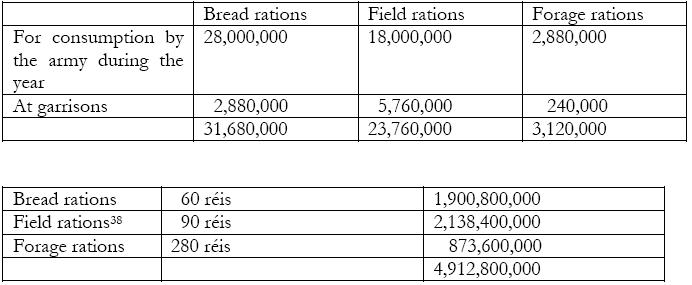
This was the calculation made of the expenditure that was necessary with the army on a war footing, in terms of what was indispensable, i.e. the subsistence of the force: almost five thousand contos.
We can conclude that the knowledge that the Lisbon government had about the financial situation of the realm would be the one that it sent to Rio de Janeiro. The chart forecasting the income of the Treasury totaled 6758 contos, already including 1600 contos originating from the defense tax. The “General chart of the net revenue of the Treasury of Portugal in the first nine months of the current year of 1809 and of what is estimated may be received in the last three months” totaled 6,885,869,803 réis.39 The “estimated” income was 6758 contos.40
The forecast for expenditure was as follows:
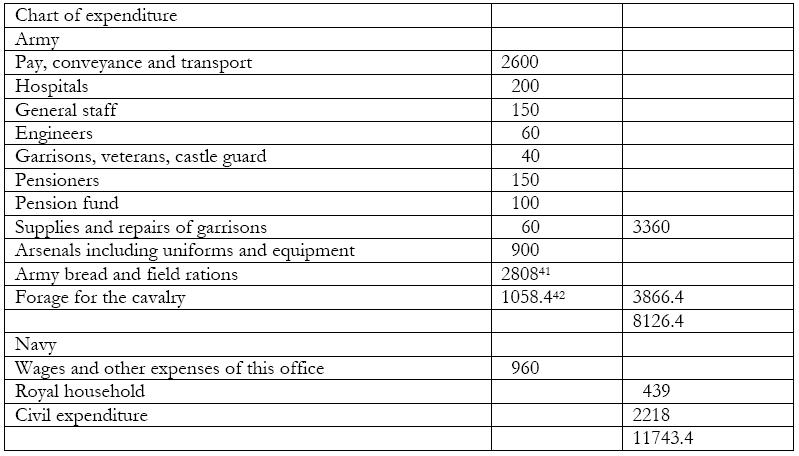
In summarized form, the panorama of the state’s financing was as follows:
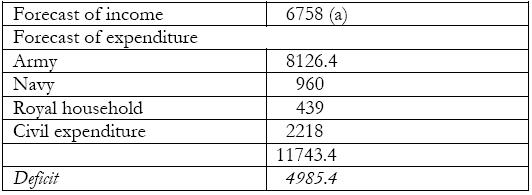
(a) including 1600 contos from the "defense tax".
The income that was forecast covered only 57.55% of expenditure. Debts totaling five thousand contos were to be expected each year. The financial question took on a clearly central importance for the government. The viability of a military mobilization depended on these resources. Merely reiterating and describing the situation was banal. The application of measures that could diminish the problem—which seemed to have no solution—this was the great challenge facing the governors of that time.
To what extent did the following years’ accounts confirm this perspective? The income of 1810 amounted to over 8776 contos, two thousand contos more than the above-mentioned forecast of October 1809, which was shown to have been very pessimistic. In fact, the difference was firstly to be found in the presence of exceptional income for 1810 (the 720 contos of the assistance arriving from Brazil via England and the 121.8 contos originating from the seizures made of French property) and in the inclusion in the chart of the tax revenue under the administration of the Loans Board (401 contos). The comparison of the two years shows that, in general, the forecasts made in 1809 of the revenue from customs duties and the taxes levied on transactions were lower than the actual reality, although it can also be seen, inversely, that the revenue from the defense tax fell far short (457 contos) of the amounts predicted.
Overall military spending amounted to 81.3% of total expenditure, and the money spent on the army was close to 70% of that total. The value of “civil expenditure” was well below the amount forecast. In this way, what was clearly visible was a sharp fall in all spending of a non-military nature. Yet the total expenditure shown in this chart did not correspond to all the expenditure that was made, but only to paid expenditure. Which is clearly demonstrated in the budget forecast for the following year, 1811:
Budget of the income and expenditure of the Portuguese Royal Treasury for the year 181143
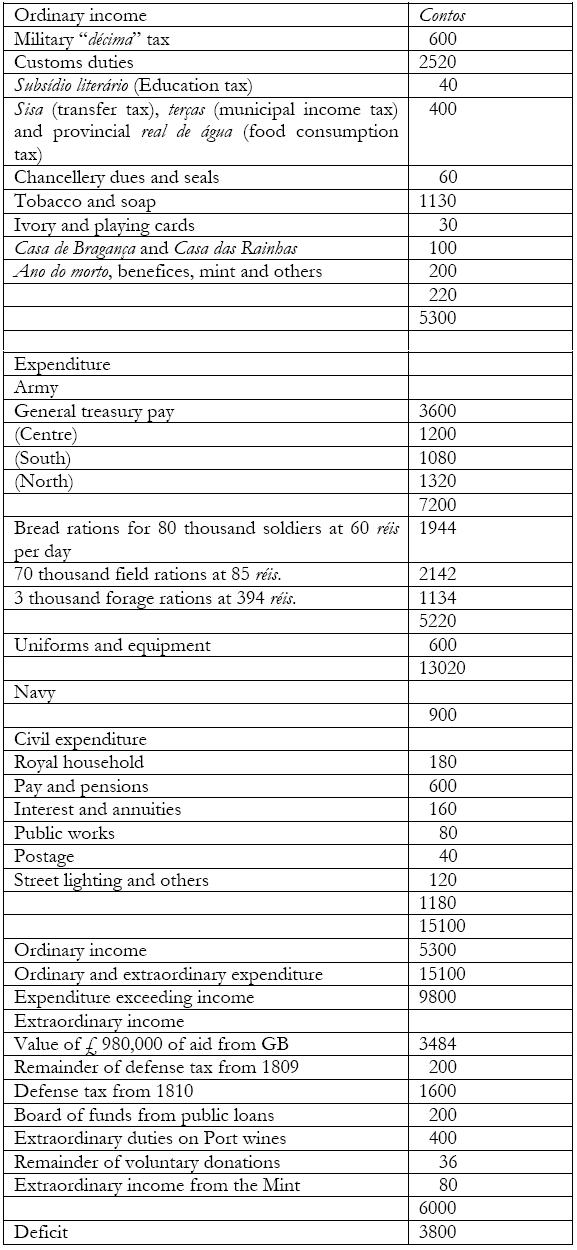
The expenditure forecast to be incurred with the army was more than 13 thousand contos, while ordinary income was estimated at only 5300 contos. An important contribution was thus provided by extraordinary income, both internal (2516 contos) and originating from British aid (3484 contos), which together exceeded the value of ordinary income. It should be remembered that, in a letter to the secretary of the British treasury, Wellington had calculated the amount needed to pursue the war in Portugal at two and a half million pounds, or, in other words, roughly 8887.5 contos. Even so, this amount was insufficient and there were expenses incurred that were not paid for.
Chart of paid and unpaid expenses in 181044
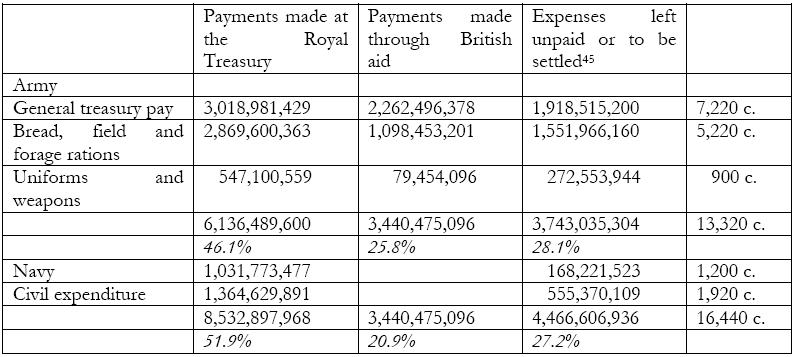
The expenses shown above for military expenditure in 1810 did not therefore include those that had been paid through the aid donated by the British, amounting to a little over 3440 contos, or 36% of paid expenses. Yet, despite this aid, it was forecast that a slightly higher amount (3743 contos, 28% of total expenses) would remain unpaid or to be settled. In this case, British aid would correspond to only a little more than a quarter of the necessary financing.
V The British financing
The value considered in the chart of 1810 was not the total amount of the expenditure made by the British government, but only the part that was placed under the administration of the governors of the realm in Lisbon. In this case, the value of 980 thousand pounds represented the compensation paid in return for increasing the number of men recruited by the Portuguese from twenty to thirty thousand. It had been difficult to obtain British parliamentary approval for this.46 The amount that the British effectively spent was twice this value: a slightly higher amount corresponded to the sending of food and other goods. The amounts of the “British subsidy” were even higher over the next few years. In fact, they did not represent a transfer to the Portuguese government, but instead amounted to all the expenses necessary to ensure the operationality of the army commanded by Wellington, the supreme commander of all forces since 1809, which, at the time of the Battle of Buçaco, was composed of roughly half Portuguese and half “British” soldiers. What was being financed by this aid was, simultaneously, the British army itself, acting in a region where it had obtained its first extremely difficult and arduous successes against Napoleon, and the government that, in a subsidiary fashion, provided some administration over that territory (Wellington, in fact, considered such administration to be scarce and weak), as well as men for the army.
We may compare the values of the British financing with the amounts that are known from the overall income of the Portuguese Treasury:
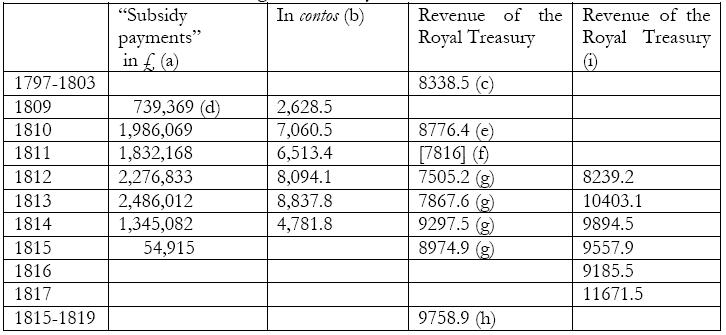
(a) Sherwig, 1969, pp. 365-368.
(b) The equivalent of the “subsidy payments” in contos de réis, with the equivalent exchange rate being considered as £1=3,555 réis
(c) Costa, 1992, pp. 20-21.
(d) Considering the amounts of £ 539,369 and only one third of the loan of £ 600,000, made on April 21, 1809 [Sherwig, 1969, p. 217]
(e) Income from 1810 [BN]
(f) Income forecast for 1811 without British aid [BN]
(g) Santana e Vasconcelos, 1865.
(h) Average income in Balbi, 2004 (1822), I, pp. 307-31
(i) Caetano, 2008, pp. 91-153, quoted data: p. 96.
We can see that, in 1812 and 1813, the British financing (in the sense established earlier) was close to the average value of the overall income of the Portuguese monarchy or perhaps (in the strictest possible terms of military spending) actually exceeded it. Although a more detailed analysis is needed of the effectiveness and application of these resources, we are looking at a sudden doubling of the resources used in the organization of war, a sudden doubling of the “State.”47 This would help to explain the capacity demonstrated by the British in gathering together the resources needed for maintaining the army.
VI The debate on the financial reform
The income continued, however, to be insufficient. Although it was not exactly a novelty in that period, the debt that was created each year as a result of unpaid expenses grew even larger, so that by 1818 it had reached 17,620 contos.48 Not all of this debt was military in nature, but quite likely, because of the suspension of “civil” payments, it originated from the priority that had been established for war-related payments. Balbi remarked in his Essai on the existence of a debt resulting from the annual deficit, the actual amount of which was largely unknown, although it would have amounted to roughly 40 million cruzados, a figure that included 12 million cruzados, or 4,800 contos, of debts relating to food supplies.49
The funds originating from internal sources of finance were insufficient to meet the exceptional expenses arising from the state of war, and this situation could only be overcome through innovative taxation measures or through recourse to loans. For the governors, the latter possibility would have the obvious advantage of not colliding with the wishes of the various social groups already in a state of greater or lesser convulsion. But traders and capitalists, who were generally reluctant to engage in operations that involved lending money to the royal administration, had exported their wealth from the realm even before Napoleon’s first incursion into the Iberian Peninsula.50
The report of the governors, dated June 12, 1809, referred to the undeniable need for some extraordinary tax. But this included a political dimension: “a decision should not be taken in a matter of such great importance without consulting the Councils and Courts (Tribunais) of the Realm, and the Senate of the Municipal Council of this Capital, which in the critical circumstances in which we find ourselves could compensate, as they had already done in 1662, for the absence of the Cortes51, suggesting gentler and more equitable means for the application of the aforesaid Tax; and we ordered them all to be consulted, making a total of seven Audiences.52
This question gave rise to very harsh criticism on the part of the government of Dom João VI in Rio, more precisely, on the part of its most prominent minister, Dom Rodrigo de Sousa Coutinho, who was displeased with the recognition of the need to summon Parliament, and, in the absence of this, to consult the “councils”.53
The first interesting aspect in this episode is the confirmation that, for the governors, the theme of a summoning of Cortes had nothing “revolutionary” about it in the (strict) sense of the installation of a “liberal” limitation upon monarchic power; it was instead “traditional”—a recourse that had belonged to the moderate monarchy, prior to “absolutism”—and was intended, above all, from the point of view of the governors, as a way of seeking to create the legitimacy needed for the introduction of new taxation. For this very reason, the governors answered Sousa Coutinho by saying that their difficulty lay in the great limitation of the powers that had been granted to them.
The governors responded to the criticism made of the reference to Cortes by alleging that the charter establishing the extraordinary defense tax did not, and indeed could not, say anything against the “Supreme Authority” of imposing taxes without consulting the People, not to mention the Cortes. Only the government in its letter about the aforesaid charter had said that a decision of such importance should not be taken without consulting the coucils, which could compensate for the absence of the Cortes, just as they had already done earlier in 1662. This was certainly not intended to offend the “Royal Power” of the Prince Regent, from which derived that of the government itself, and of all the other authorities. In this explanation of the situation, the government’s sole aim had been to justify the fact of its having imposed, by means of a charter, the largest tax that there had ever been in the realm, when the last orders had taken away from it almost all jurisdiction over such matters and reduced the same government to a simple “Consultative and Informing Council,” showing that it had not done so arbitrarily, but in a case of extreme necessity.
The governors resented the limitation of their powers. Furthermore, the serious practical problem had been identified of a new imposition for whoever governed. If the aforesaid tax did not gain general approval, it would be poorly received, would not be paid and would be impugned because whoever had decided it did not have the jurisdiction to do so, because, despite the secret nature of government, news had leaked out of the restrictions established by the first royal charters, and the “Partisans” (those who dedicated themselves to creating factions) and “Emissaries” (the supposed agents of the enemy who were present within the territory) would take advantage of the reluctance shown by the “People.”54
With this same aim in mind, that of creating less resistance to the payment of the tax, specific reference was made to the property of both the Church and the Crown, which should be given a special tax status. This was to be done in order to assuage the displeasure that was attributed to most of the “nation” and the “public opinion,” which considered the property of the Church and the Crown, specially destined for the defense of religion and the monarchy, to be equally under attack by this war, which was also a war of religion. They had therefore agreed upon an extraordinary defense tax in the form that was stated in the “charter of the 7th instant.”55
The second important aspect of this debate was the full confirmation of the fondness that Dom Rodrigo de Sousa Coutinho had for the intransigently non-liberal, “absolutist” and “Pombalist” pattern of exercising power on behalf of a king, which it is not within the scope of this paper to investigate any further here.56
Another financial possibility would be to seek recourse to foreign credit, more precisely to that originating from London. But this also proved to be impossible, as was pointed out by the Count of Funchal, the ambassador in that city, who explained that the difficulty that there was in sending money from that country made recourse to a loan taken out there unfeasible, no matter whether it was secured by the credit of the Portuguese government or any other source of security. Wellington had aired the need for creating a bank in Lisbon so that such an operation could be carried out. But, in July, 1812, Dom Miguel Pereira Forjaz had made it known to the ambassador that the governors of the realm did not think that the establishment of a bank might have sufficient foundations to guarantee the success of this venture, since it did not seem to them to be useful to increase the mass of paper money that was already in circulation, considering it more convenient that the count should limit himself to requesting the loan “separately,” or, in other words, without any other conditions.
But, in view of what he considered to be an unrealizable task, he concluded that the “sole recourse” that remained was to sell the lands of the Church and the Crown and also the “feudal” rents and entitlements in the possession of the Crown or the clergy. Such an expedient was imagined as an operation that would allow for the rapid creation of credit securities. The count explained that, as soon as a property was put up for sale and a value established for observation, some immediate relief might be obtained by offering those who had credits an amount of up to no less than two hundred cruzados for immediate payment in bills with five per cent interest that would be paid on the purchase of the land. Should the bearers of these credits not wish to be buyers, these bills would be paid, according to the order of their dates, from the product resulting from the sales. This would make it possible for other bills to be accepted immediately. All of this presupposed that there were social groups “thirsty” for the acquisition of these properties and who, by racing to buy land, would increase the value of the new securities that were issued.57
The theme of selling the property of the Crown and the property of the Church (both of which were implicitly afforded the status of being available by decision of the government) moved to the forefront of financial debates. This perspective, within the limited scope of the Crown, had an effective application in the sale of the Crown’s available property, although its results were not very significant.58 But this hypothesis of selling the property dated from the end of the 18th century. The head treasurer had already mentioned in 1798 “also the sale of properties, leases and lands, both of the Crown and the Orders, except for that which is destined for the service of His Majesty and the gathering of fruits, with the respective councils taking responsibility for these sales, and with the property of the Orders being given appropriate securities with the due payment of interest at six per cent in order that they might not be prejudiced.” And he further went on to mention “the sale of the inalienable properties, leases and lands of the Crown, giving them securities that can produce the income that they lose, warning that if everything is to be valued at its right price no bid should be accepted that is lower than the capital of five per cent of the current rent of the properties and lands and in the leases, the capital that is equivalent to twenty years of these same rights with three pensions paid on alienation of the lease.” He further talked about “the silver that is not needed at the Royal Household, and that of the churches, except for the sacred vessels and pieces of insignificant weight,” stressing that the fascination for silver not only belonged to foreign plunderers.59
Other, somewhat bolder proposals were also made, such as the one put forward by Vicente José Cardoso da Costa, involving a hypothesis that proved not to be acceptable at that time.60
In practical terms, the possibility had been established in 1799 of buying back the Crown’s leaseholds. An operation had also been undertaken involving the sale of the available property of the benefices of the military Orders, which had made it possible (at least) to find “manor houses” for two families of rich businessmen from Lisbon, the Pessoa Tavares and the Machados, who bought the estates of Vargem and Benagazil, names that bought with them the titles of baron that their descendants were to enjoy. Other businessmen had also taken advantage of this opportunity to buy other estates.61
But, for investment in agriculture to be attractive, the man who had inspired this policy considered it essential for the “feudal rights” (as they were still described at that time) that continued to be such a heavy burden in certain regions to be either abolished or at least moderated.62 This was the supposed compensation that Sousa Coutinho envisaged for the effects caused by Lisbon’s losing its role as an entrepôt for Brazilian products. But what interests us here, within the context of the impasse in terms of financial policy, is the appearance of this possibility of there being a certain innovation introduced through the capital that was represented by the extensive estates of the clergy. It was accepted that the administration could realize this capital by selling these estates, thus benefiting the public income and the new owners of this property. Perhaps the actual size of these assets was overestimated, as most certainly was the thirst that had been believed to exist on the part of wealthy men, considered eager to buy them.63
Conclusion
After the reestablishment in Lisbon of a government that claimed the sovereignty of the House of Bragança, following on from the defeat that the British forces had imposed on Junot’s army, the kingdom of Portugal was to find itself in a situation of complete demilitarization, further exacerbated by the absence of any tradition of effective organization for war purposes. In 1808, plans were afoot for the raising of a large force, but this was far from being achieved. The chart of February 1809 presented numbers that, if they were real, would have meant a very different evolution from the one that actually happened. Beginning in the months of March and April of that year, the leadership and orientation of the nation’s defense were once again handed to the British officers. Between 1809 and 1811, there existed an overall force of between 48 and 52 thousand men, with a cavalry that was always short of horses. Such a force would be equivalent to the mobilization of almost one out of every two single men aged between 16 and 30. Finding mounts for all the cavalrymen that were planned would mean using almost all the horses existing in the kingdom.
The traditional difficulties of military recruitment persisted, despite the evident danger of confronting an invading army that was destroying the towns and villages through which it passed. The administration tried to introduce stricter penalties, with the state adopting “tyrannical” practices, interfering in the sphere of the property of those who did not submit to its will. But as the general superintendent of police noted, the laws seemed to lose their authority when one was fighting against the solidarity of family members and the common people.
Besides men and horses (and other essential equipment that has not been mentioned here, such as transport), the army that was recruited called for different sources of finance. The Treasury’s income was far from matching its level of expenditure, even after the creation of extraordinary defense taxes and the cutbacks imposed on all other expenditure. An important part of military expenditure was covered by the British subsidy. Another part was allowed to take the form of a debt. The amounts provided by the above-mentioned British subsidy between 1809 and 1814 lead to doubling the value of the resources mobilized by the state in Portugal itself and this explained (at least a large part of) the organization of the so-called allied army. Despite the adverse conditions, the insufficient income called for a debate on innovative measures that might make it possible to change a panorama of unfeasibility created by the lack of resources.
We can compare the published numbers of the men belonging to each regiment on 31 December of the successive years of 1809, 1810 and 1811:
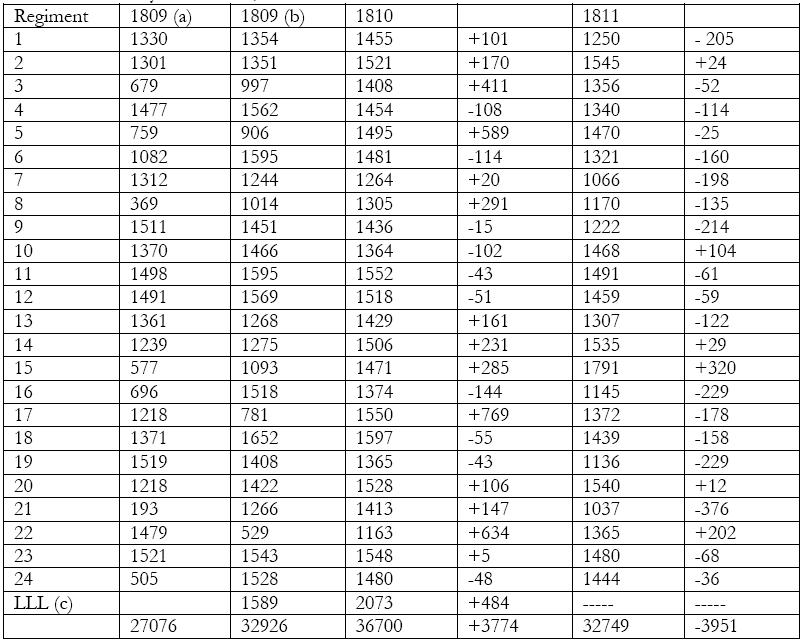
(a) Oman, II, p. 629.
(b) Couto e Melo, Repertorio das ordens do dia dadas ao exército português de 15 de Março de 1809 até 5 de Abril de 1830, Lisbon, 1830, pp. 210; 251-53; 269-71.
(c) – Leal Legião Lusitana, which was disbanded in 1811.
Numbers of cavalrymen and horses – 1809-1811
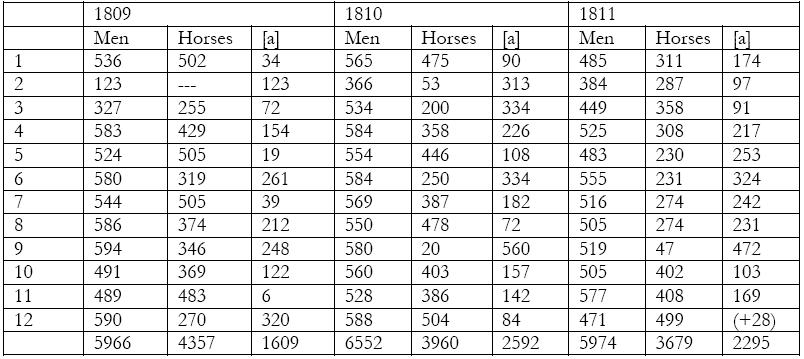
[a] – number of horses missing
The quantity of foodstuffs necessary for the rations was as follows:
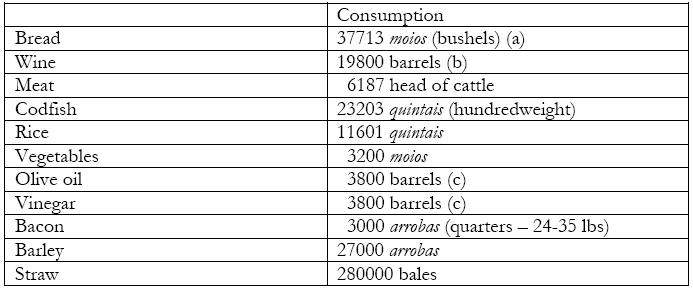
(a) at 14 rations per alqueire (1 alqueire = 13-22 liters)
(b) barrels of 25 almudes (1 almude = 4.5-6.5 gallons)
(c) barrels of 25 almudes
Appendix nr. 4
“Chart of the revenue of the Treasury of Portugal, in which an approximation or estimate is made, according to the current circumstances, of the net annual product of each item,” appendix to the official report of the governors of the realm nr. 25 of October 23, 1809.
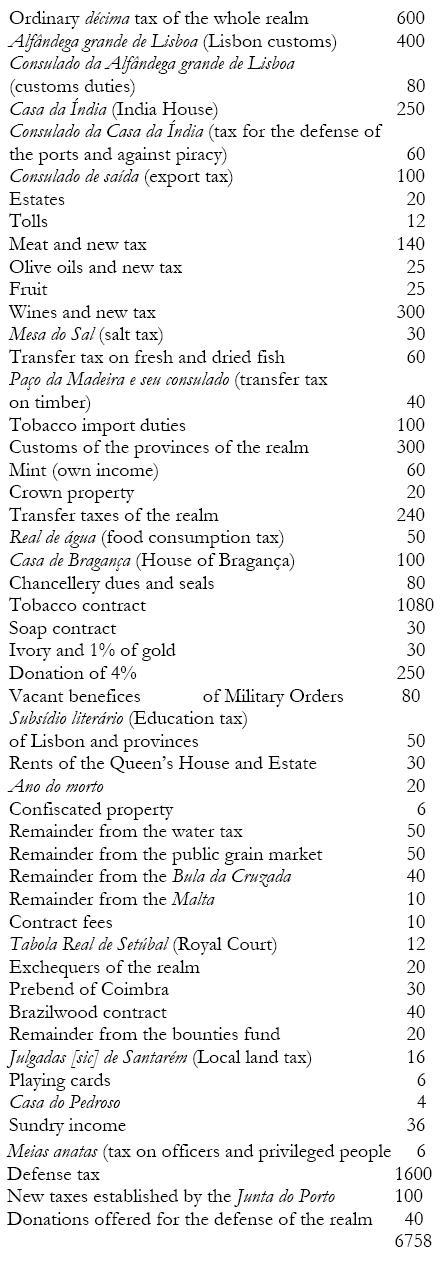
Appendix nr. 5
Statement of income and expenditure of the Royal Exchequer in 181064
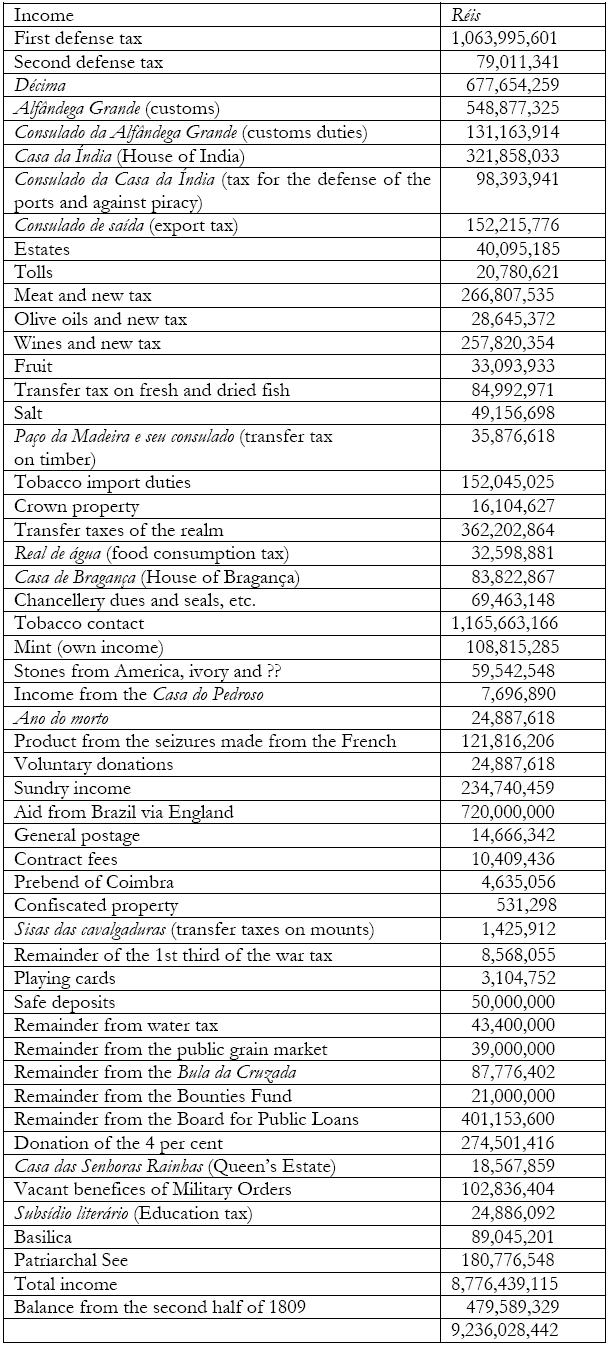
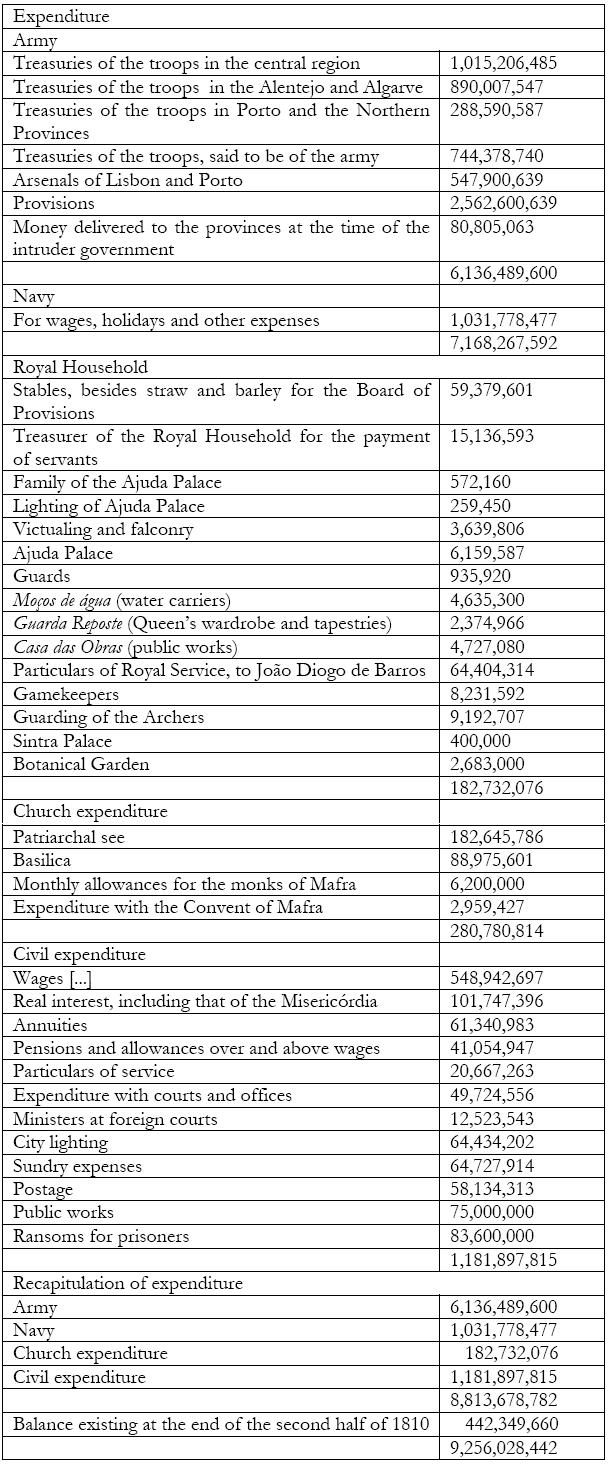
Notes
1Torre do Tombo (TT), Conselho de Guerra, 283,967,86, June 12, 1810.
2A recent narrative of the Peninsular War written in English: Esdaile, 2004.
3TT, Reino, Book nr. 324, f.4.
4It does not fall within the scope of this article to analyze the intense debate about the reforms of the military system, which took place after the trauma of the 1801 war, and which led to the penal reformulation of 1805 and the reorganization of 1806. Both of these events did, in fact, have little practical importance after the cuts that resulted from the events of 1807–1808. On the absence of any military tradition and the debate taking place at the beginning of the 19th century, see Costa, 2005.
5Boppe, 1897.
6Ferrão, 1923.
7“concealing their feelings and their customs, and prostrating themselves with respect before whoever has their property and their lives in their hands.” Letter of May 24, 1806, Correspondance de Napoléon, 1943, p. 329.
8Woolf, 1992.
9TT, Reino, Idem, Report nr. 5, dated January 25, 1809, f. 14.
10Idem, 5th letter, dated January 25, 1809.
11The Lines of Torres Vedras were a defensive system in the Lisbon region, bordered on either side by the ocean and the River Tagus and to the north by a network of military posts built on the high points of the area in order to seek to impede, or at least delay, the advance of an army heading towards the capital along the existing roads. The building of this system in a way that was to prove decisive in the campaign of 1810 was decided by Arthur Wellesley in October, 1809, although the planning for the construction of a similar system had already been undertaken by the Portuguese officer Neves Costa in May, 1809.
12Claudio de Chaby, Synopse dos decretos remetidos ao extinto Conselho de Guerra, volume VII.
13The creation by the governors of merely fictitious forces that had no practical expression in reality was already an established tradition [Costa, 2005]. What is interesting is the possibility that it may have been thought that the “patriotic uprising against the French,” despite its not having been militarily relevant, could bring to the army a population who would now look differently upon their entry into the ranks, or, in other words, who had abandoned their traditional repugnance for military service.
14Chaby, op. cit., pp. 121-126.
15Estado actual do Exercito Portuguez {report sent as an appendix to the statement of the governors of the realm to the Prince Regent, of March 10, 1809, TT, Ministério dos Negócios Estrangeiros (MNE), cx. 885}
16Report of May 31, 1809, TT, MNE, Cx. 885, nr. 1.
17 Report of August 14, 1809, Idem, nr. 8.
18 Fernando Dores Costa, Insubmissão..., op. cit., 2005.
19TT, MNE, Cx. nr. 885, nr. 8.
20“Mappa Geral das differenças acontecidas em altas e baixas nos corpos de linha do Ex[ercito] de SAR desde Janeiro de 1810 até Junho de 1811,” Boletim do Arquivo Histórico Militar, 51 (1982), pp. 236–37.
21Another question, which goes beyond the scope of this preliminary analysis, is that of the forces that were effectively engaged in combat, as well as the major problem of integrating the Portuguese soldiers into the army organized by the British.
22[The Governors of the Realm instruct that you should immediately send the necessary orders to all of the commanders of the region under your government, when drawing up the lists of their companies, to complete the charts that are now being sent to you, in which they will declare by companies the number of young single men that there are in each of these with their classification by ages as shown on the same forms, as well as the number of caçadores by profession comprising the age group of 20 to 35 years. And, as soon as you receive the charts of all the commanders’ regions, you shall draw up a similar chart, recapitulating all the others, which you shall then send to this SENEG (Office of the Secretary State for Foreign Affairs and War) as soon as possible.] For this purpose, the above-mentioned forms were included for the collection of the names of the parishes and young single men. Forms were also sent for reporting the names of the single men of each parish aged between 30 and 40, and of those aged between 18 and 30, who were exempt from recruitment as front line troops, as well as for reporting the names of the married men of each parish aged between 18 and 40.
23 “Mappa Geral dos Moços solteiros sujeitos ao Recrutamento no anno de 1808”, appendix to the official letter of the governors of August 14, 1809, ANTT, MNE, Box nr. 885.
24 For another exercise in comparing the population and the fighting strength of the army, based on the reflections of Franzini, see Costa, 1998, pp. 973–974.
25On the movements against the “French” and the “Jacobins,” see Costa, 2008.
26Costa, 2005.
27 TT, CG, 282,965, nr. 3, December 24, 1808.
28TT, CG, 282,965, nr. 54, August 4, 1809.
29Francisco António Maciel Monteiro, Lisbon, June 6, 1810, CG, 282,965, nr. 82.
30The capitães mores lead the ordenanças as a wider militia, assembling supposedly all males from 16 to 60 year old living in the area of a capitania mor. Another militia, the auxiliares, organized the more vacant men to create a second line force and rearguard of the professional army.
31 Lisbon on June 15, 1810, the General Superintendent of the Police of the Court and the Realm, Lucas de Seabra da Silva, TT, Conselho de Guerra, Bundle nr. 283, Box nr. 967.
32 [Nr. 63, of August 2, 1810]
33[Nr. 72, of July 7, 1810]
34Apparently, the petitioner ended up obtaining a favorable solution to his case. Although the superintendent concluded that it seemed that Lourenço Teixeira should not be granted exemption, the following words can be found written in the margin, in pencil, and therefore difficult to read: “Let him go and it would be advisable to investigate all the clerks at the different Tribunals and divide up and distribute those who are indispens[able][...]” [Nr. 86, June 12, 1810]
35For some information about the activity of recruitment after 1811, see Francisco Arturo de la Fuente, 1980.
36 AHM, 1-14-22-05.
37[Chart calculating the cost of sustaining the army, appendixed to the report of the governors of the realm nr. 25, dated October 23, 1809]
38 The necessary foodstuffs were identified. See Appendix nr. 3.
39Of which 5,678,269,803 réis related to the nine months already mentioned and 1,207,600,000 réis was the income forecast for the remaining three.
40See table in Appendix nr. 1.
41 Much lower value than the one quoted in the above-mentioned estimation of 4039.2 contos.
42Higher value than the one quoted in the above-mentioned estimation of 873.6 contos.
43Biblioteca Nacional, Cod. 6939, f. 52.
44BN, Cod. 6939, f. 53.
45These amounts were deduced from a rough estimate of the effective expenses, which correspond to the “rounded off” amounts shown in the last column.
46John M. Sherwig, Guineas and Gunpowder. British foreign aid in the wars with France. 1793-1815, Harvard University Press, 1969, p. 226.
47It should be noted that the available effective value of the British subsidy may have been lower, if one considers the problem of discounting the bills of exchange through which the transfer was made and their exchange into metallic money for payment purposes.
48Piteira Santos, 1980, p. 107.
49Balbi, 2004 (1822), I, p. 325.
50The preamble to the publication of the Balance of Trade in 1813 stated that “political motives had caused large funds to be moved to England”: Jorge M. Pedreira, Estrutura industrial e mercado colonial. Portugal e Brasil (1780-1830), Lisbon: Difel, 1994, p. 322. Junot wrote to Napoleon on January 19, 1809, saying that 50 million francs had left Portugal. On this general transfer to Great Britain of capital that was under threat, clearly demonstrating the extent of the integration of financial markets, see Larry Neal, The rise of financial capitalism, CUP, 1993, pp. 180-181.
51The traditional meeting of the three estados: Nobility, Ecclesiastic and Povos, i.e. cities and villages having the right to send its representatives.
52Report nr. 14, TT, Reino, 314, f. 38v.
53This reaction was quoted in Oliveira Lima, 1908, and is also referred to by Lyra, 1994.
54Report nr. 31, TT, Reino, 314, f. 62.
55TT, Reino, 314, f. 38v.-39.
56 See: respostas vindas do Rio – Reino, 380, August 30, 1809.
57Arquivo do Tribunal de Contas, ER, Box Nr. 86, nr. 14. Costa, 1992, p. 147.
58José Tengarrinha, 1993.
59“Memórias do Tesoureiro-mor. 1798”, Capela, 1993, pp. 239-248, p. 243.
60 “Memória economico-juridica sobre o projecto dos resgates dos direitos enfiteuticos e censuais dos corpos de mão morta. 1799”, Lisbon, August 19, 1799, Capela, 1993, pp. 257-276.
61Costa, 1992, pp. 201-202.
62On the question of town charters in the 1820s, see Nuno Gonçalo Monteiro, 2003, pp. 179ff.
63The position of Principal Sousa, who voted in isolation in favor of the application of the reform of agrarian taxes, is not dealt with in detail here. The other governors did not follow him. Ricardo Raimundo Nogueira criticized the inopportune nature of such an initiative.
64BN, Cod. 6939, f. 50.
Sources and Bibliography
Manuscript sources
Biblioteca Nacional
Reservados, Cod. 6939
Torre do Tombo
Conselho de Guerra, maços n.º 282, 283
Ministério do Reino, livros n.º 314, 380
MNE, cx. 885
Tribunal de Contas
Erário Régio, cx. n.º 86
Printed Sources
Boletim do Arquivo Histórico Militar, 51 (1982)
Correspondance de Napoléon: six cents lettres de travail (1806-1810), présentées et annotées par Maximilien Vox, 11e éd., Paris : Gallimard, 1943.
Bibliography
Araújo, Ana Cristina (1985). “Revoltas e ideologias em conflito durante as invasões francesas”, Revista de História das Ideias, 7: 7-90. [ Links ]
Balbi, Adrien (2004). Essai statistique sur le royaume de Portugal et d'Algarve, Lisbon: INCM, 2 vols. [1822].
Boppe, P. (1897). La Légion Portugaise: 1807-1813, Paris: Berger-Levrault.
Caetano (2008), António Alves, A Economia Portuguesa no tempo de Napoleão, Lisbon: Tribuna da História.
Capela, José V. (1993). Política, administração, economia e finanças públicas portuguesas (1750-1820), Braga: Instituto de Ciências Sociais da Universidade do Minho.
Chaby, Claudio de. Synopse dos decretos remetidos ao extinto Conselho de Guerra, vol. VII, Lisbon, 1889.
Costa, Fernando Dores (1982). Crise financeira, dívida pública e capitalistas: 1796-1807 [polic.], Lisbon: Universidade Nova de Lisboa.
Costa, Fernando Dores (1998). “O bom uso das paixões. Caminhos militares na mudança do modo de governar”, Análise Social, 149: 969-1017. [ Links ]
Costa, Fernando Dores (2005). Insubmissão. Aversão e inconformidade sociais perante os constrangimentos do estilo militar em Portugal no século XVIII [polic.] Lisbon: Universidade Nova de Lisboa.
Costa, Fernando Dores (2008). “Franceses e «jacobinos». Movimentações «populares» e medidas de polícia em 1808 e 1809. Uma «irrupção patriótica»?”, Ler História, 54: 95-132. [ Links ]
Ferrão, António (1923). A Iª invasão francesa: a invasão de Junot vista através dos documentos da Intendência Geral da Polícia, 1807-1808: estudo político e social, Coimbra: Imprensa da Universidade.
Lyra, Maria de Lourdes Viana (1994). A utopia do poderoso Império: Portugal e Brasil : bastidores da política 1798-1822, Rio de Janeiro: Sette Letras.
Melo, Couto e, Repertório das ordens do dia dadas ao exército português de 15 de Março de 1809 até 5 de Abril de 1830, Lisbon.
Monteiro, Nuno Gonçalo (2003). Elites e poder: entre o Antigo Regime e o Liberalismo, Lisbon: Imprensa de Ciências Sociais.
Neal, Larry (1993). The rise of financial capitalism, Cambridge and New York: Cambridge University Press.
Oman, Charles (1995). A History of the Peninsular War, II, Greenhill Books, [1902].
Pedreira, Jorge (1994). Estrutura industrial e mercado colonial: Portugal e Brasil (1780-1830), Lisbon: Difel.
Santos, Fernando Piteira (1980). Geografia e economia da revolução de 1820, 3ª ed., Mem Martins: Europa-América.
Sherwig, John M. (1969). Guineas and Gunpowder. British foreign aid in the wars with France. 1793-1815, Harvard University Press.
Tengarrinha, José (1993). “Venda dos bens da coroa em 1810-1820: os reflexos de uma crise nacional”, Análise Social, XXVIII, 122: 607-619. [ Links ]
Vasconcelos, Jacinto Santana (1865). Relatório acerca dos impostos e contribuições directas,Lisbon.
Woolf, Stuart (1992). La Europa Napoleónica, Barcelona: Editorial Crítica, [1990].














